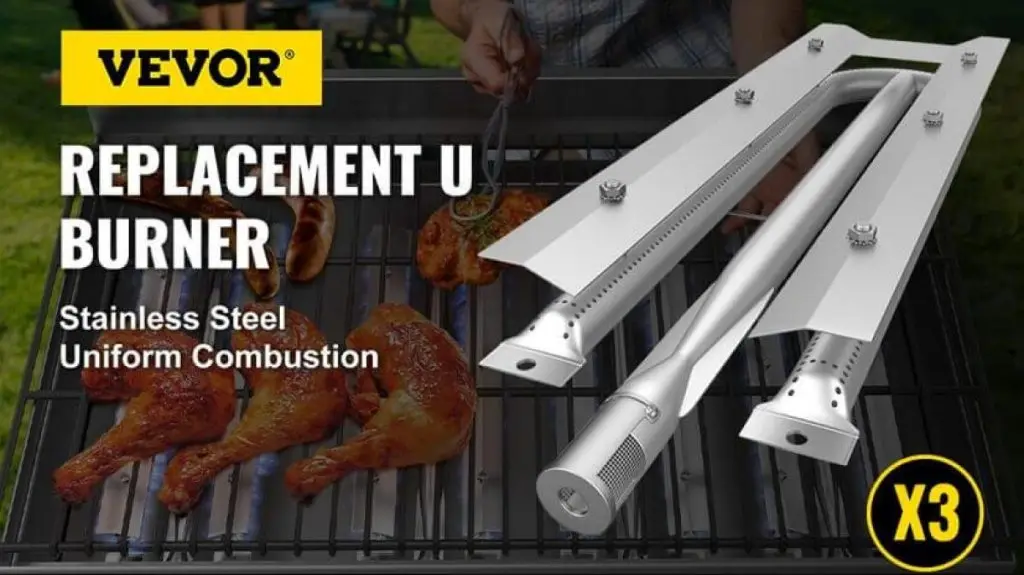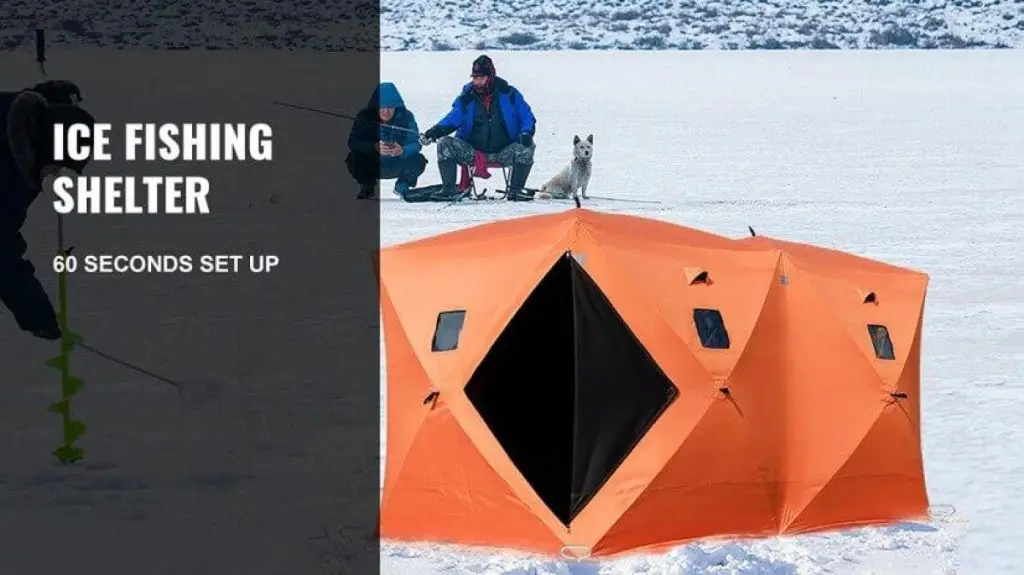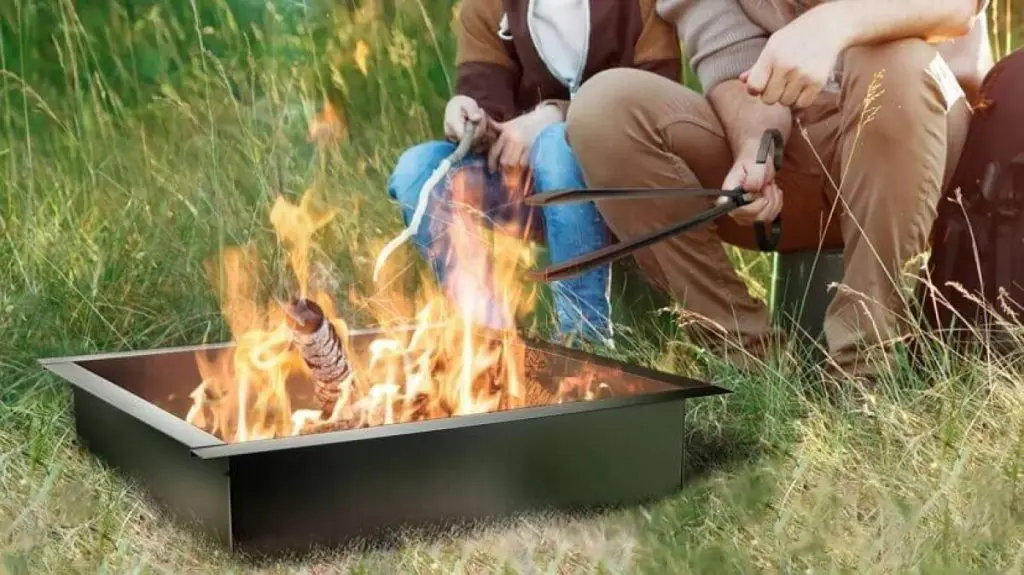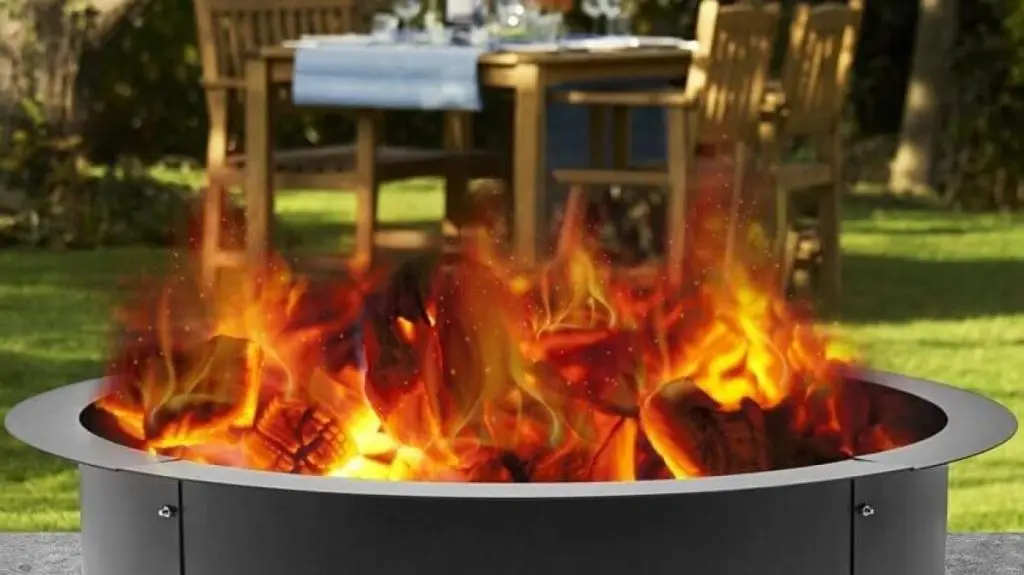Camp cooking is fun, but it becomes a headache when your cooking setup is not organized.
You just unpack grocery bags and start cooking haphazardly, thinking you will handle the mess once your tummy is full. But later, you find yourself tipping over utensils and envying the family camp next to you with a well-organized camping kitchen setup.
A well-organized camp kitchen setup is a life-changer for camping enthusiasts and adventurers. With a well-equipped campsite kitchen setup, camping outdoor cooking becomes a breeze. It enhances your overall camping experience by allowing you to efficiently prepare tasty meals in the great outdoors without compromising the flavor or quality. If you are a camping enthusiast but have difficulty cooking at the campsite, continue reading.
In this comprehensive guide, we will discuss all about effective camping kitchen setup—from necessary equipment to setup ideas and key considerations—to make outdoor camp cooking easier and more enjoyable for you.

What Do You Need for an Outdoor Camping Kitchen?
To establish an outdoor campsite kitchen for an enjoyable cooking experience, you will need the following essential camping kitchen equipment:
1. Camping Kitchen Table
Camping kitchen tables are perfect for proper storage and organization of campsite kitchen setups. Most camping kitchen tables are foldable and can easily be folded and packed in a small bag, making them easier to carry around.
2. Camping Stove
When it comes to outdoor campsite cooking, having a reliable camping stove is a must. Look for portable and fuel-efficient camping stoves that are simple and quick to set up. While white gas is the most common fuel for camping stoves, most camping stoves can also burn kerosene and diesel. You can also consider tent wood stoves.

3. Cooking Utensils
For optimal outdoor cooking experiences, you need to have a set of cooking utensils like pots and pans, spatulas, tongs, knives, cutting boards, can openers, etc. Look for durable nonstick cookware suitable for outdoor campsite cooking.
4. Food Storage Containers
Proper food storage is key to keeping ingredients fresh and organized. So invest in airtight containers to store both perishable and non-perishable items. Consider stackable options if space is an issue in your camping kitchen, or you can look for resealable bags.
5. Tableware
Be sure to bring durable yet lightweight tableware, such as plastic or stainless steel materials, that are easier to clean for serving and eating meals. Focus on the storage space they will take while selecting tableware for your outdoor campsite kitchen setup.
6. Water Storage
Water storage containers and collapsible water jugs will help ensure an ample water source at your campsite for cooking, cleaning, and staying hydrated. A collapsible water tank bladder can help take care of your campsite water needs.
7. Cooler or Freezer
For optimal freshness of perishable food items and to keep your beverages cool, consider investing in a quality cooler or a portable refrigerator. This portable camping fridge features an LCD panel, allowing you to easily control temperature.
8. Camping Grill
If grilling is your favorite method of cooking while camping, your camp cooking setup would be incomplete without a camping grill. So, do not forget to bring along a camping grill or portable bbq grill for grilling delicious camping meals.
With all these essential items ready at hand, you can have the best camp kitchen setup, perfectly equipped to handle all culinary adventures in nature!
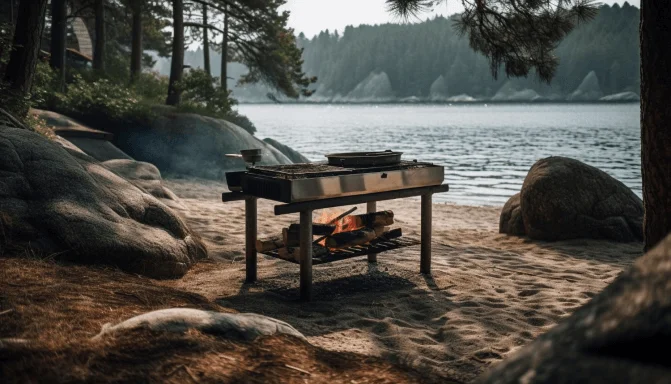
Camping Kitchen Setup Ideas to Simplify Cooking
Setting up a camping kitchen that is organized and functional will enhance your cooking experience in nature. Whether you are an outdoor enthusiast or embarking on your first camping adventure, these camping kitchen setup ideas are designed to simplify and make campsite cooking more enjoyable for you. By following these practical suggestions, you can build a well-equipped camping kitchen tailored specifically to meet your unique needs and preferences.
Let’s dive in!
1. Pick a Sheltered, Flat Area
The stability of the kitchen setup is key to a smooth cooking experience. A wobbly camping kitchen workstation can make campsite cooking a headache for you. Therefore, when setting up your camping kitchen it is crucial that you find a flat area where you can easily set up your folding camp station for an effortless cooking experience. And if possible, try to find a sheltered area that will provide a cover against direct sunlight and wind. Cooking under a shelter will not only help protect you from weather elements when cooking in great outdoors but will also help maintain consistent temperatures.
2. Plan Your Workspace for Maximum Flow
A successful camping kitchen relies on efficient workflow. To optimize workflow in the kitchen, arrange your equipment, utensils, and ingredients in a way that supports an effective workflow. Keep frequently used items within easy reach so you can move around more freely throughout your kitchen. Setting up your kitchen for maximum flow might take some time, but it will save you a lot of time and trouble when cooking. Also, given that you won’t have to scratch your head when looking for things like ingredients or a pot, you can focus on cooking mouthwatering meals while enjoying nature.
3. Store Bins and Coolers Under the Table
When setting up your campsite kitchen for maximum space optimization, make use of every corner. One of the most commonly overlooked areas is the space under your camping kitchen table and workstation. You can easily make use of this space by fitting your storage bins and coolers beneath your tables. This will help optimize space and make your camping kitchen setup more organized and ensure easy access.
That said, it is suggested that you do not place the cooler with drinks underneath the cooking table, as it might affect your cooking experience as people might ask you to hand them a drink again and again, which could get frustrating at times. Place the cooler with veggies and other cooking stuff only under the cooking table.
4. Create a Drinks Station
For easier beverage accessibility and less disruption during cooking, create a drinks station dedicated to beverages with its own cooler or camping fridge. This will ensure that your fellows do not come your way when they come to get a drink, allowing you to enjoy uninterrupted cooking. By setting up such a camping kitchen, you can enhance your campsite cooking experience and allow everyone to remain hydrated and refreshed with easy access to drinks.
5. Campfire Grill Grate
When camping with open-fire cooking in mind, bring along a campfire grill grate that can be set directly atop the flames for optimal results. With it, you can grill meats, veggies, and even toast bread directly over the fire. A campfire grill is an indispensable cooking accessory for any camping kitchen setup. It not only adds a rustic charm to your camping experience but also tantalizes your taste buds with smoky-flavored meals.
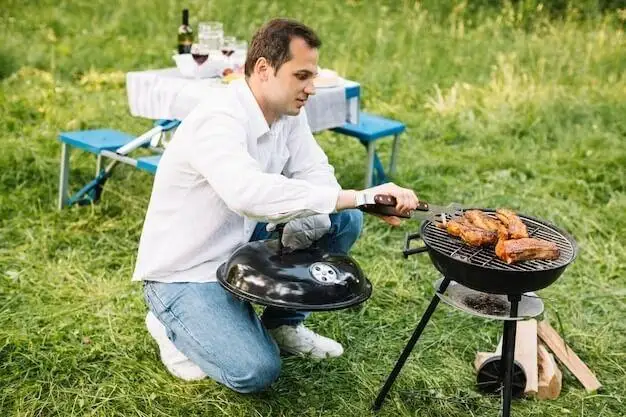
6. Sort Your Trash
Camping takes a toll on nature in a noticeable way when campers are irresponsible. Therefore, it is crucial that you set up your campsite kitchen for maximum cleanliness and implement a trash sorting system to reduce your environmental footprint. Designate separate bins or bags for recyclables, compostable, and general waste. Make sure that you follow all applicable waste disposal regulations at your campsite. Try to strictly follow the Leave No Trace principles to ensure that your camping has little to no negative impact on the environment.
7. Collapsible Sink
Effective dishwashing is key to keeping a camping kitchen sanitary. So, invest in a collapsible or portable camping sink for easier and more effective dishwashing. These lightweight pieces of equipment provide dedicated space for washing dishes and utensils, allowing you to uphold proper hygiene in your campsite kitchen.
8. Set Up a Hand Washing Station
While you can use a dishwashing sink for washing hands, to ensure optimal hygiene in your camping kitchen, create a separate hand washing station near it containing water with a spigot, biodegradable soap, and towels or paper towels for drying hands. A dedicated hand washing station promotes proper hand hygiene for reduced risk of contamination while creating an ideal cooking environment for you and fellow campers alike.
9. Camp Kitchen Box
When packing for camping trips, utilize a dedicated camp kitchen box to store all your cooking essentials. This could be anything from plastic storage bins to purpose-built camping kitchen boxes with compartments designed to store utensils, spices, condiments, and other kitchen accessories. Having a designated camping kitchen box will make transport and setup of your campsite kitchen easier.
10. Lighting Solutions
Dining after the sunset has its own charm. But once the sun goes down, you will need lighting solutions to properly illuminate your workspace and cooking area to be able to cook dinner comfortably. Utilize battery-powered LED lanterns, string lights, or headlamps to illuminate your camping kitchen setup and create an ideal setting for cooking to continue even after the sun has set.
Be sure to tailor these camping kitchen setup ideas according to your unique needs and preferences in order to achieve maximum functionality and efficiency for camping outdoor cooking.
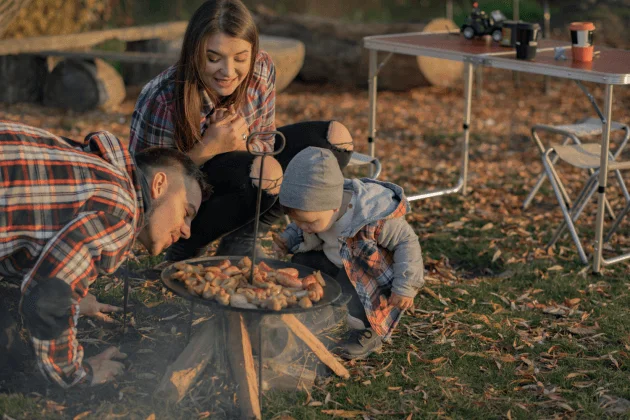
Considerations When Selecting an Outdoor Camping Kitchen
Establishing an outdoor camping kitchen involves more than simply installing equipment and organizing supplies. To ensure an enjoyable and sustainable camping experience, it is crucial that you consider the following:
● Safety and Hygiene Outdoors: Prioritize food safety and hygiene by employing proper food handling and storage methods. Separate raw and cooked food items and use insulated coolers to maintain safe temperatures for storing the foodstuffs safely. Do not forget to clean cooking surfaces thoroughly after each use, and follow basic food safety guidelines when camping to prevent foodborne illness outbreaks.
● Improvising With Limited Resources: Camping can often require resourcefulness and flexibility in how we utilize our resources, so be prepared to improvise and use what resources are available creatively. For instance, if you don’t own a traditional stove, you could use a portable camping stove or even cook over an open campfire with a campfire grill that will go atop the campfire. Look for different ways of accomplishing tasks while keeping up with the adventurous spirit of camping!
● Cleanup and Maintenance in Camp Kitchens: For optimal performance in future camping trips, proper care must be taken when cleaning and storing equipment to extend its longevity and ensure a pleasant cooking experience. Immediately following each use, clean and dry all utensils, pots, and pans thoroughly to avoid rust formation. Moreover, store equipment away in airtight storage spaces, protected from moisture to prevent corrosion.
● Weather Considerations for Outdoor Cooking: Weather can dramatically affect your camping cooking experience. Be ready for rain, wind, or extreme heat by having an action plan in place to shield your cooking area from elements by using a canopy or windbreak and adapting your techniques and recipes accordingly. If you could find a sheltered spot for your kitchen setup, it would be just perfect.
● Camping Kitchen Practices for Environmental Sustainability: When camping, follow Leave No Trace principles to minimize your impact on the environment. Properly dispose of waste and comply with campground rules regarding recycling and waste management. Avoid single-use plastic items; instead, use reusable containers and eco-friendly cleaning products to lower your footprint. Make sure that you leave the camping site in as good or better condition than it was found.
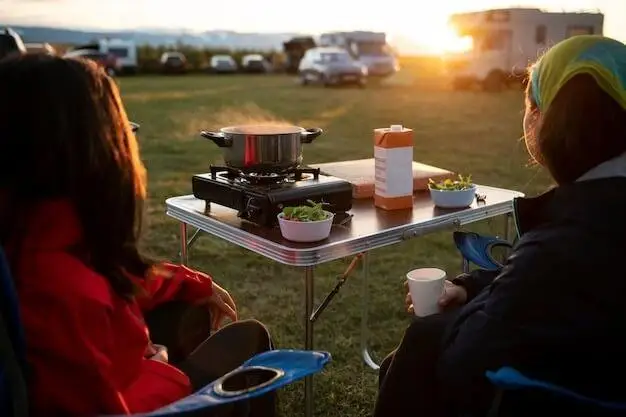
FAQs About Camping Kitchen Setup
Planning your camping kitchen setup, you may have questions regarding best practices, equipment, and tips to ensure an enjoyable outdoor cooking experience. Below, we have answered some of the most commonly asked questions about camp kitchen setup.
Q: How can I optimize space in my camping kitchen setup?
You can employ various strategies to help optimize space in your camping kitchen. Starting with collapsible or nesting cookware that is easily stackable and stored can help optimize space. You can also consider using camp kitchen boxes or camp kitchen tables that come with hanging zippered storage compartments. Consider adding multi-use items, such as a pot with a lid that doubles as a plate, for space optimization when camping out.
Q: Which cooking equipment is recommended for outdoor camping?
When packing equipment for outdoor camping cooking, a camping kitchen table, a portable camping stove or grill, and cookware is absolutely necessary. For an efficient and enjoyable camping cooking experience, you must also pack tableware, food storage containers, cutting boards, knives, collapsible water jugs, a fridge, and cooler, etc.
Q: What material should be used for making a camp kitchen?
Your choice of camp kitchen equipment depends entirely on your personal tastes and requirements. Popular choices for camp kitchen equipment include stainless steel, as it is long-lasting, resistant to rusting, and easy to maintain. That said, it could be heavier compared to other materials, such as aluminum. Aluminum also conducts heat well, which makes cooking efficient. However, aluminum items might not last as long.
Another alternative could be cast iron, which provides excellent heat retention/distribution capabilities but requires regular maintenance to prevent rusting.
Q: Are there any camping kitchen hacks or tips for making meal preparation easier?
Absolutely! To simplify meal preparation when camping, try pre-measuring ingredients and packing them in individual containers or bags, saving both time and items needed for meal prep. When choosing what to cook on the campsite, consider one-pot meals that are not only easier to cook but also easier to clean. Use foil packets or disposable oven bags for easier, mess-free cooking, as this allows food to cook directly within these packets while preserving flavors and minimizing cleanup.
Furthermore, prepping ingredients, such as chopping veggies ahead of time, can save valuable time at camp while making meal preparation easier.
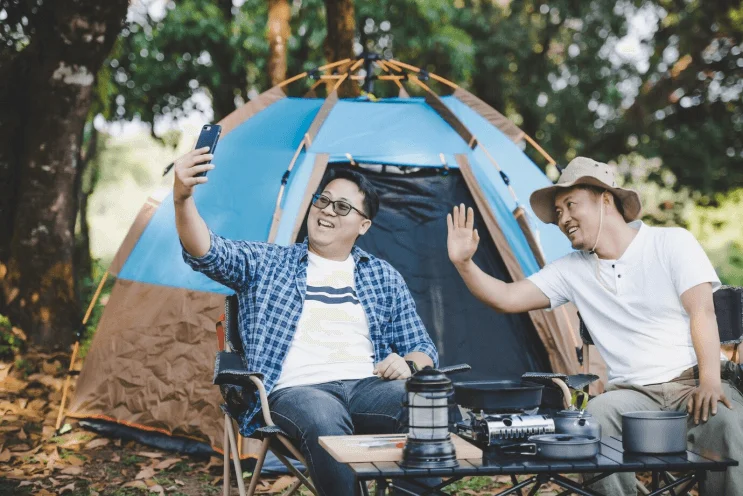
Camping Kitchen Setup: Concluding Thoughts
Camping is all fun until the hunger strikes, and you find yourself cooking haphazardly with all the cooking material scattered around you. Having an organized outdoor camping kitchen setup is crucial for a seamless outdoor camping cooking experience. And to set up and organize the kitchen, you have got to pack essential items such as a camping kitchen table, stove or grill, cooking utensils, food storage containers, tableware, etc.
By following the advice in this article, you can set up an effective and functional camping kitchen tailored specifically to meet your outdoor campsite cooking needs. With the appropriate equipment and planning in place, your camping kitchen will soon become the centerpiece of delicious meals and unforgettable outdoor experiences. So start preparing now for your next camping journey, and discover its pleasures through outdoor camping cooking.


